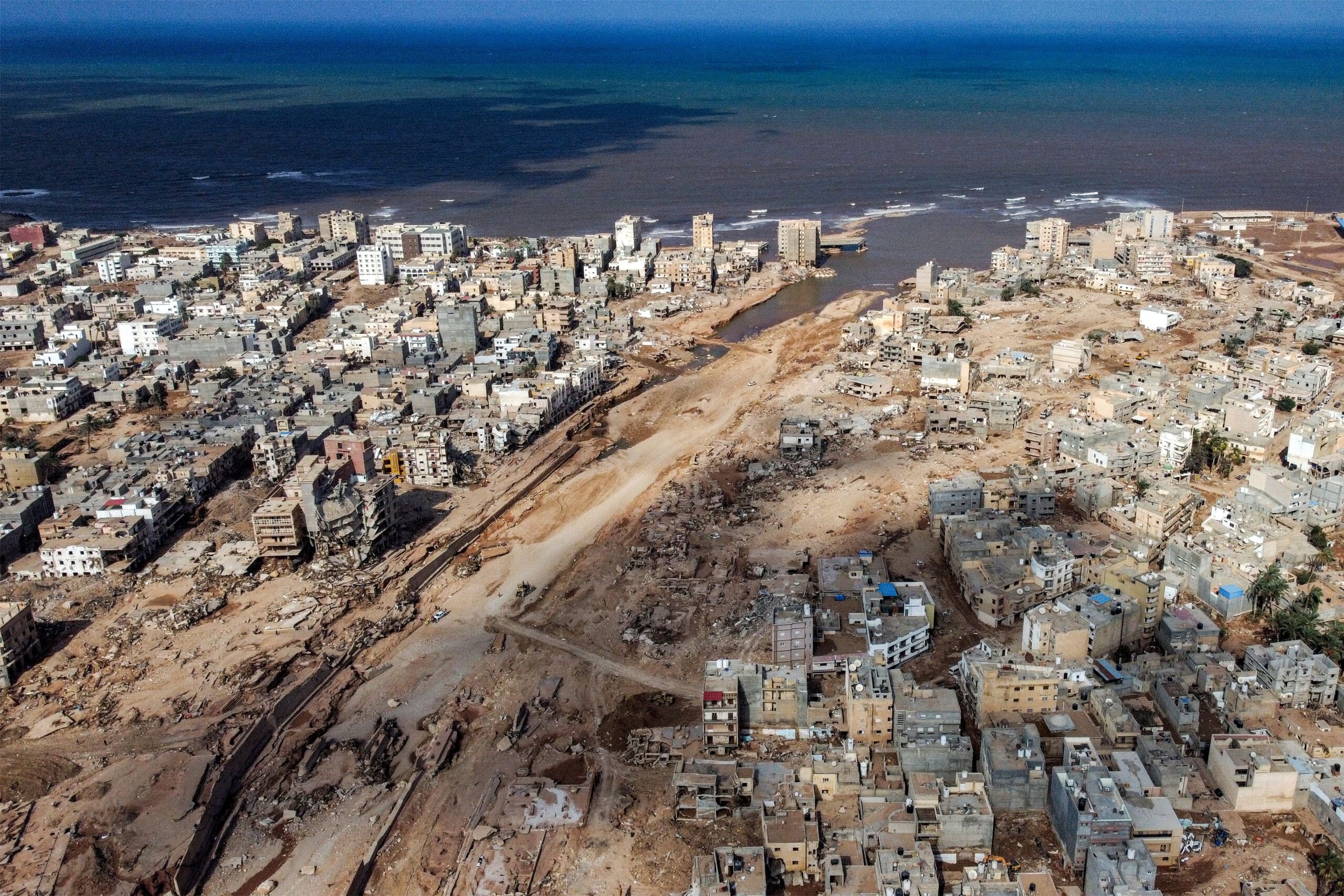
An aerial view shows Libya’s eastern city of Derna on September 18, 2023, following deadly flash floods. FILE PHOTO/Agence France-Presse
TRIPOLI — A year after flooding in eastern Libya killed thousands and razed entire neighborhoods, reconstruction is allowing military strongman Khalifa Haftar to wield further power in the divided country, experts say.
On September 10, 2023, extreme rainfall from the hurricane-strength Storm Daniel caused two dams to burst in the coastal city of Derna, some 1,300 kilometers (800 miles) east of the capital Tripoli.
This led to flooding that killed nearly 4,000 people, left thousands missing and displaced more than 40,000 others, according to the United Nations.
READ: Libyans protest against authorities in flood-hit Derna
The tragedy sent shockwaves across the oil-rich North African country, casting a harsh light on Libya’s crumbling infrastructure and the dysfunction among its divided rulers, and sparking angry demands for accountability.
Libya is still grappling with the aftermath of the armed conflict and political chaos that followed the 2011 NATO-backed uprising that toppled long-time dictator Moamer Kadhafi.
The country is now divided between an internationally recognised Tripoli-based government in the west, led by interim Prime Minister Abdulhamid Dbeibah, and a rival administration in the east backed by Haftar.
READ: Flood-hit Libyan city facing long recovery as search for missing goes on
Derna, once home to around 120,000 inhabitants, has become a vast construction site, where homes, schools, roads and bridges are being rebuilt.
But the massive reconstruction effort is underway without any oversight from the authorities in Tripoli.
‘Blank cheque’
In February, the speaker of the eastern administration’s parliament, Aguila Saleh, announced the creation of a reconstruction fund headed by Belgacem Haftar, one of the strongman’s six sons.
By doing that, parliament gave Haftar a “financial carte blanche” worth 10 billion dinars ($2.1 billion), said Libya analyst Anas El Gomati.
“It’s a blank cheque with zero oversight,” added Gomati who heads the Sadeq Institute think-tank.
READ: Searchers look for more than 10,000 missing in flooded Libyan city
Reconstruction should be supervised by UN agencies and local elected officials who “would prioritise needs, merit and anti-corruption measures”, he said.
Instead, it is being carried out by “an impenetrable institution where billions vanish”, said Gomati.
The Haftars are “not rebuilding Derna, they are building their political launch pads”, said the analyst.
“Every brick laid in Derna is a stepping stone in their succession plan,” he added, referring to Haftar’s children.
Belgacem Haftar is the figurehead of Derna’s reconstruction, and unlike his brothers Saddam and Khaled, he holds no military role.
He could use his position to “establish political standing at the national and international level”, said Jalel Harchaoui, a Libya expert at the Britain-based Royal United Services Institute.
And as a whole, the Haftars could use their political clout to show that the UN-recognised government in Tripoli is “ineffective and superfluous”, he added.
‘Minimize culpability’
On Thursday, during a visit to the south, Belgacem Haftar claimed that 70 percent of reconstruction projects in Derna had been completed.
He said 3,500 homes have been rebuilt, while maintenance work had been done on the city’s power grid and in schools.
Authorities say they have also made some progress in judicial cases against those responsible for the disaster.
In late July, 12 unnamed civil servants were given prison sentences of between nine and 27 years for their roles in managing the collapsed dams.
This aerial view shows the ruins at the site of the ancient Greco-Roman city of Cyrene (Shahhat) in eastern Libya, about 60 kilometers (37 miles) west of Derna, on September 21,2023, in the aftermath of a devastating flood. FILE PHOTO/Agence France-Presse
The two dams were built in the 1970s by a Yugoslav company, but received very little maintenance work despite a budget being allocated.
High-ranking officials, such as the mayor of Derna who happens to be a nephew of Saleh, were not investigated.
The mayor’s house had been set on fire after the flooding during angry protests by demonstrators demanding accountability from the eastern-based authorities.
Families of the victims have also contested the death toll announced by officials in the east.
Officials have said around 3,800 people were killed in the floods — based on the number of bodies buried — but the families believe many more died.
According to Gomati, a death toll of “14,000 to 24,000” is more plausible.
So far, “10,000 DNA samples from people still searching for their loved ones” had been collected, he said.
The authorities in the east have been “minimising the death toll (in order to) minimize their culpability”, said Gomati.

